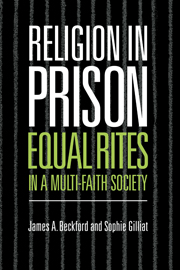Book contents
- Frontmatter
- Contents
- List of figures
- List of tables
- Abbreviations
- Preface
- 1 Equal opportunities and multiculturalism in prisons
- 2 Chaplaincy, chaplains, chapels and other faiths
- 3 Church of England prison chaplains
- 4 Visiting Ministers of other faiths
- 5 ‘Facilitation’ or ‘dependence’?
- 6 Inclusion and exclusion
- 7 Prison chaplaincy in the United States
- 8 Conclusions: state, church and diversity
- Notes
- Appendix
- References
- Index
6 - Inclusion and exclusion
Published online by Cambridge University Press: 22 August 2009
- Frontmatter
- Contents
- List of figures
- List of tables
- Abbreviations
- Preface
- 1 Equal opportunities and multiculturalism in prisons
- 2 Chaplaincy, chaplains, chapels and other faiths
- 3 Church of England prison chaplains
- 4 Visiting Ministers of other faiths
- 5 ‘Facilitation’ or ‘dependence’?
- 6 Inclusion and exclusion
- 7 Prison chaplaincy in the United States
- 8 Conclusions: state, church and diversity
- Notes
- Appendix
- References
- Index
Summary
Writings on ecumenical co-operation and inter-religious tolerance are extensive. It is not difficult to expound ideas about the common sympathies and affinities which, on a theoretical level, unite the practitioners of all religions in solidarity against the forces of secularism and indifference. It is widely believed that intolerance is the result of ignorance and misunderstanding on all sides. The solution is to make people knowledgeable about their own and others’ religious traditions. The theory is that knowledge and understanding will cancel out ignorance and fear. This is a simple, liberal theory about the connection between knowledge, understanding and tolerance; and there is nothing wrong with it as a theory. But this way of thinking about the relations between religious and faith traditions fails to pay sufficient attention to the practice of social relations. We mean that the theory is silent about the fact that members of different religions do not interact in a vacuum (Séguy 1973). Rather, they meet as rivals for jobs, as competitors for resources and public esteem, as superiors and subordinates in organisations, as neighbours in residential areas, and so on. It is in these everyday social settings that religious faiths encounter one another. This is when the theory of religious tolerance is tested.
Prisons are ‘extreme’ social settings (Goffman 1968; Cohen & Taylor 1972). They amplify the ‘noise’ of ordinary social life by intensifying competition, rivalry, hostility, manipulativeness and vindictiveness – as well as friendship, altruism, solidarity and generosity.
- Type
- Chapter
- Information
- Religion in Prison'Equal Rites' in a Multi-Faith Society, pp. 142 - 170Publisher: Cambridge University PressPrint publication year: 1998



